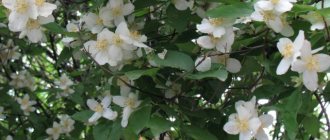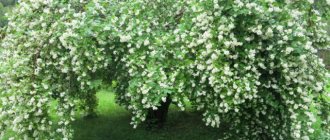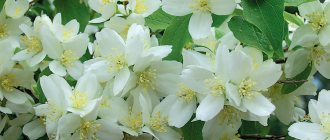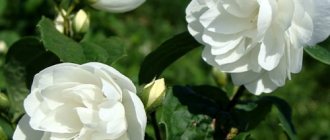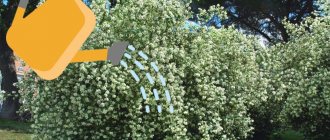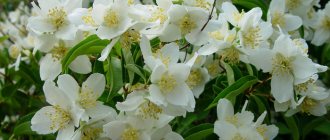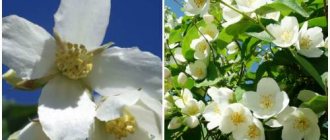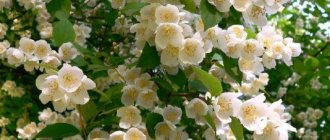Mock orange (Philadelphus) It is one of the popular ornamental shrubs; currently more than 30 species have been introduced into cultivation; the number of varieties is in the hundreds. People often call mock orange jasmine for its white fragrant flowers, which really look like jasmine. But still, mock orange is a plant of a different family, so in the literature this name is used with clarification - syringa.
The plant looks especially impressive during flowering in early and mid-summer. Snow-white flowers cover the branches so abundantly that it seems as if there was a snowfall in the garden.
Let's take a closer look at this beautiful plant. The Latin name Philadelphus is given in honor of Ptolemy Philadelphus, king of Egypt. In our country it has long been called mock orange, since it was convenient to make chibouks for smoking pipes from strong wood with a soft core.
Mock oranges are very shade-tolerant, but they develop better and bloom more abundantly in the sun. Different varieties and species bloom at different times, mainly from late May to late July. Some mock oranges are extremely fragrant, others have a subtle smell, and there are mock oranges without any smell at all.
Briefly about the plant
Since mock orange saturates the garden with a wonderful aroma, gardeners often call it jasmine. The bush blooms with boiling white flowers.
Jasmine is an upright growing shrub that is covered with a gray crown, and in the fall sheds leaves, the color of which changes from green to yellow. Considering the height of the bush, it can be dwarf (up to 70 centimeters), medium or large (up to six meters). The leaves of the plant resemble the shape of an egg, slightly elongated and wide. The length of the leaves is 2 – 7 centimeters. Leaves can be double or semi-double. Jasmine blooms for two to three weeks. If you choose the right plant varieties, mock orange will bloom throughout the summer:
- in June, small-leaved varieties bloom, only one meter high with small leaves and beautiful bowing shoots. This mock orange smells like strawberries, so it attracts both people and insects;
- the thin-leaved variety of jasmine also blooms in the first rows. Its height is more than two meters;
- At the end of summer, varieties that have large leaves and dense crowns bloom.
Gardeners plant species and varietal plants on their territories, since mock oranges do not need special care and are not too whimsical. But for the winter, the bushes must be covered so that they do not disappear due to the cold winter weather.
Against the background of brick walls, you can plant a luxurious, vigorous, spreading bush. It will harmoniously and effectively decorate the largest garden.
Mock orange combines harmoniously with weigela, hydrangea, and lilac. It will stand out brightly among trees with bright leaves or an openwork crown. In autumn, jasmine with yellow leaves will go well with plants that have purple leaves (maple or hazel).
Lemoine mock orange (Philadelphus x lemoinei)
Lemoine's bush ( Philadelphus x lemoinei) is spreading, up to 1.5–2 m tall, with dark green leaves.
It blooms in June-July for three weeks. The flowers are white, 2–4 cm in diameter, with a strong aroma, collected in racemes.
It is a hybrid between small-leaved mock orange and coronata , in cultivation since 1884. The author is one of the most famous breeders, Frenchman Victor Lemoine, thanks to whom many beautiful varieties have appeared.
Mock orange Lemoine Dame Blanche (White Lady)
- Dense shrub up to 1–1.5 m.
- The flowers are semi-double, creamy white, with a pleasant scent.
Lemoine's mock orange Manteau d'Hermine (Ermine mantle)
- Bush up to 1–1.5 m tall, with graceful hanging branches.
- It blooms very profusely for twenty days. The flowers are double, creamy white, up to 3 cm in diameter, with a pleasant scent.
Mock orange Lemoine Erectus (Vertical)
- Up to 2 m tall, with branches growing vertically upward.
- The flowers are numerous, non-double, up to 3 cm in diameter, white, with a strong strawberry scent.
Mock orange Lemoine Virginal
- Bush up to 2–3 m tall.
- It blooms in July, sometimes blooming again in September. The flowers are in large dense inflorescences, large, up to 5 cm in diameter, snow-white, fragrant, double.
Mock orange Lemoine Virginal
Mock orange Lemoine Innocence
- Bush up to 2 m tall. The leaves are variegated - green, with creamy white or yellow spots. Blooms in June.
- The flowers are single, white, with a strong aroma.
- Winters with shelter.
Mock orange Lemoine Belle Etoile (Beautiful Star)
- A small spreading shrub up to 1.5 m tall and 2 m in crown diameter.
- The flowers are in inflorescences, large - about 5 cm in diameter, single, fragrant, white with a mauve center and bright yellow long stamens.
- This variety is heat-loving; it needs to be covered for the winter and the tree trunk area mulched.
Mock orange Lemoine Belle Etoile (Beautiful Star)
Mock orange Lemoine Schneesturm (Snow Storm)
- Spreading shrub up to 3 m tall and 2 m in crown diameter.
- It blooms for about twenty days with large, 4–5 cm in diameter, double snow-white flowers collected in inflorescences. There are so many flowers that the leaves are often not visible because of them.
Mock orange Lemoine Schneesturm (Snow Storm)
About the coronary mock orange
Aureus coronata has yellowish or red-brown young shoots with dense leaves. The leaves of the bush are oval in shape, bare on top and pubescent along the veins below. Fragrant creamy-white flowers are collected in racemes.
The bush blooms for 22 days. Tolerates twenty-degree frosts. It is planted in parks and gardens.
Types of mock orange
In nature, 50-70 species are known that grow in temperate latitudes of Eurasia and America. All mock oranges are spreading deciduous shrubs; in nature they grow in the undergrowth of broad-leaved and mixed forests, in clearings, along the edges and among thickets of bushes, often singly or in small groups.
Crown mock orange (Philadelphus coronaris)
Mock orange crown is the most common type of mock orange in landscaping. Found in gardens and parks everywhere. The height of the bush is up to 3 m. It grows quickly, longevity is 30 years. The leaves are large and serrated. Blooms profusely and for a long time, 20 days. The flowers are very fragrant, up to 3.5 cm in diameter. In autumn the leaves turn yellow. This is the most winter-hardy species, withstanding frosts down to -25 C. We list the most interesting and popular varieties:
Mock orange "Aurea" is a showy variety with golden yellow leaves. For planting, you must choose a sunny place, since in the shade the golden color of the leaves disappears and becomes normal green.
Mock orange "Variegata" - a variety with variegated leaves, white and yellow spots make the crown contrast with other shrubs.
Mock orange crown "Anomala" (Anomala) - the variety is distinguished by a compact, elegant crown shape, no higher than 1 m in height. The flowers have a pink center inside the corolla.
Schrenk's mock orange (Philadelphus schrenkii)
Schrenk's mock orange blooms in Moscow at the end of May, one of the first among other species. At this time, it is abundantly covered with white fragrant flowers, collected 7-9 pieces in dense short inflorescences.
The flowers are quite large, up to 4 cm in diameter, flowering duration is 25 days. The homeland of this species is the Far East, Korea, China. It can be distinguished by its hairy young shoots and pubescent flower columns. In our conditions, the bush grows up to 2 m in height, has characteristic ovoid-shaped leaves, narrowed at the top. The species is winter-hardy, withstands frosts down to – 25 C.
Small-leaved mock orange (Philadelphus microphyllus)
Small-leaved mock orange came to us from another part of the world, its homeland is North America. It blooms at about the same time, at the end of May. A low-growing, multi-tiered bush with an openwork crown. The shoots are thin, shiny, the leaves are not large, lanceolate. Strawberry-scented flowers completely cover the bush during flowering. This species is the ancestor of the most beautiful decorative forms and varieties.
Downy mock orange (Philadelphus pubescens)
Fluffy mock orange, on the contrary, blooms late, in the second half of July - early August. It got its name from the lower pubescence of the leaves. It grows naturally in the forests of North America and was introduced into cultivation quite a long time ago (since 1800). This is a tall shrub, up to 3 m tall, with a crown diameter of 1.7 m. The flowers are almost without aroma, but they are large and collected in fairly dense clusters of 5-10 pieces.
Odorless mock orange (Philadelphus inodorus)
Mock orange is odorless. Homeland - North America. The bush reaches 3 m in height. The leaves are large, 7-12 cm. The flowers are white, odorless, up to 5 cm in diameter, collected in racemes of 3 or 5 pieces.
Mock orange "Grandiflorus" is a taller form with a tall spreading bush up to 4 m high and up to 3 m in diameter. The bark is brown. It blooms a little later - at the end of June, with large, odorless flowers up to 6 cm in diameter. The flowers are unusually beautiful - snow-white, with wide petals, forming an almost square shape in general, with very numerous stamens. It has a record long flowering period (up to 30 days). Tolerates partial shade well.
Lewis mock orange (Philadelphus lewisii)
Lewis mock orange is abundant at the end of June; the flowers are white, cup-shaped, up to 4 cm in diameter, collected in large racemes. The bush reaches 2.5 m in height.
Gordon's mock orange (Philadelphus gordonianus)
Gordon's mock orange is one of the tallest species. It can reach 4 m, and sometimes, when shaded, in search of light, it throws out branches up to a height of 5-6 m. The bark of the shoots is yellowish and smooth. The leaves are bright green, shiny, up to 8 cm, pubescent below. The flowers are pure white, slightly fragrant, up to 4.5 cm in diameter, collected in dense inflorescences of 7 or 9 pieces. It blooms in June-July annually and very profusely.
Pointed mock orange (Philadelphus satsumanus)
Pointed mock orange or Yokohama mock orange (Philadelphus yokohamae) is extremely rare in our gardens. In its homeland in Japan, it grows as a tall shrub up to 2 m high, but in cultivation its height does not exceed 1.5 m. The leaves are large and pointed. Flowers bloom in mid-June. They are small, elegant, white, collected in 5-9 pieces in dense inflorescences with a subtle, mild aroma.
Pekin mock orange (Philadelphus pekinensis)
Peking Chubushnik from Northern China and Korea has a height of up to 1.6 m. It has medium-sized foliage and original white-cream flowers up to 3 cm in diameter with a subtle aroma. The petals are wide, located in the same plane. Blooms from late June to mid-July.
Lemoine mock orange (Philadelphus lemoinei)
The parade of mock orange species is completed by the species that produced the most beautiful varieties. Lemoine mock orange is a hybrid of common mock orange and small-leaved mock orange (Philadelphus pallidus x Philadelphus microphyllus). It blooms in July for up to 20 days with pure white flowers collected in racemes and has a strong aroma. It has been used by foreign and domestic breeders to create many magnificent varieties.
Chubushnik Lemoine "Virginal" (Virginal) - the variety was obtained by Lemoine in 1909. It is distinguished by large, double, snow-white, goblet-shaped flowers up to 5 cm in diameter. The bush reaches a height of up to 2 m.
Chubushnik Lemoine "Mont Blanc" (Mont Blanc). The variety is quite stable in central Russia. Forms a tall bush (up to 1.8 m) with large leaves. The flowers are semi-double, pure white, gracefully shaped, fragrant. The petals of the lower circle are very wide, beautifully bent back, the inner ones are few, curled inward.
Chubushnik Lemoine "Alabaster" (Alabaster). Straight bush up to 2 m high, snow-white semi-double flowers, fragrant, large, collected in clusters of 7-9 pieces. The inner petals are narrower and few in number. It blooms on average 10 days later than the crowned mock orange, and for a very long time (up to 35 days).
Varieties of mock orange
There are many different varieties of mock orange. There are bushes that easily tolerate frost, and there are those that only love warm weather. The most popular varieties of mock orange:
- variety "Variegata" has original two-color leaves. They are green in the center and have light edging around the edges. The shrub blooms with snow-white flowers with cream centers. Jasmine has a thick, spreading crown. Grows up to two meters. Blooms in late spring, early summer for 25 days. Variegata loves sunny areas and fertile, moist soils. Fertilized with mineral fertilizers. For wintering, bushes need to be covered. Used to create hedges and beautiful landscape compositions;
- The “Snow Storm” variety has double snow-white flowers, bright green monochromatic leaves, and a strongly pronounced and pleasant aroma. It grows up to three meters and blooms in July for 25 days. It is recommended to prune shoots that are more than four years old so that the bush blooms profusely every year. This variety often suffers from aphids, so it needs to be treated with special protective agents;
- The “Pearl” variety has large snow-white, double flowers, plain bright green leaves, as well as curved red-brown branches. Grows up to one and a half meters. It blooms in mid-summer and blooms for two to three weeks. The variety is not afraid of frost. Grows best in fertilized sunny soils. They decorate front gardens and flower beds;
- the variety “Airborne” has flowers that resemble small bells of white or cream color. In the center they are decorated with yellow stamens. Blooms profusely and fragrantly. The bush has straight branches with green leaves. Reaches a height of two meters. It blooms for a month even in a shaded place. This variety withstands frost and is not afraid of disease. They decorate lawns and large flower beds;
- variety "Gordon" has white flowers with a weak aroma, large leaves with a glossy top. Reaches 4 – 6 meters in height, blooms at the end of June for 20 days. It is important to systematically prune outdated branches. Most often, this variety of jasmine is planted to provide shade from the scorching sun on a hot summer day;
- The Lemoina variety has a large crown, snow-white flowers that are collected in beautiful inflorescences, and large dark green and yellow leaves. The bush smells strong and cloying. Grows up to three meters. It blooms in mid-summer, sometimes again in the fall for 20 days. Lemoine blooms in the shade and withstands winter. It is used to decorate plots and create hedges;
- The “Komsomolets” variety is rich in white double flowers, a light, airy aroma, and graceful, elongated leaves. Grows up to two meters. Blooms for 20 days in midsummer. If the weather is too dry, it is important to water the bush regularly. Chubushnik can withstand even thirty-degree frost in winter. It is easy to care for, which is why gardeners often plant it in their gardens;
- the “Gnome” variety does not throw out buds for flowering. It grows low, has bright, small, jagged leaves and a dense crown. Tolerates winter. This type of mock orange is used to decorate borders, flower beds, and create landscape compositions. Since the branches are too thick, you can trim the bush to give it any shape;
- The “Alabaster” variety blooms with snow-white, semi-double flowers. The flowers that are inside are too small and thin. Each inflorescence contains 10 flowers. The bush has oval, green, medium-sized leaves, strong and spreading branches. Grows up to two meters. Blooms for 35 days in midsummer. It is important to prune the branches every year. Plant this variety of mock orange only in a sunny place, as even with slight shading, the bush may not bloom. If, if necessary, you feed the plant and water it regularly, you can get a hedge, as well as a single decoration for the area;
- the fluffy variety of mock orange has lower leaves that resemble airy cups. The flowers are odorless, but very beautifully shaped, which are collected in large inflorescences of 10 pieces. A plant of this variety blooms in July–August. The shrub grows up to three meters.
Chubushnik crown: description
Although mock orange has no economic value (despite its aroma, even the honey plant is extremely weak), this plant has been cultivated in the Middle East since the 12th century. This shrub has been decorating the gardens of Russian tsars and boyars since the 16th-17th centuries. Europe discovered mock orange a little later, only at the beginning of the 19th century.
The Russian name of the shrub comes from the word “chubuk” - branches with a soft, easily removable middle and dense, hard wood are well suited for making chibouks and mouthpieces. The pipes made from it were famous for the same reason. But in Latin the genus is called Philadelphus.
The bushes were named after the ancient Egyptian king Ptolemy Philadelphus. This king (by the way, the son of Cleopatra) valued plants that were distinguished by both beauty and aroma. True, it is not known for certain whether mock orange, jasmine or another plant grew in the royal garden.
It is not easy to distinguish mock orange and jasmine seedlings, and the unpretentious northerner is not sold under the proper name “false garden jasmine.” As a result, gardeners are disappointed: mock orange is an ornamental and fragrant shrub, but it is not jasmine.
In addition, these crops require different care. To purchase what you want, you need to choose trusted nurseries, and in the case of jasmine and mock orange, you also need to find out the Latin name of the plant. Mock orange is Philadelphus , and jasmine is Jasmнnum.
Plant characteristics
The mock orange genus is not uncommon. The natural home of this shrub is equally western and eastern Europe, northern Africa, the Middle East and even North America. There are from 50 to 70 wild species. Many of them served as the basis for the selection of cultivated varieties that grow comfortably north of their natural range, including in Russia.
- The crowned mock orange reaches a height of 3-4 meters , although there are species no more than 70 cm high.
- The shoots are flexible , straight, thin, reddish-brown in color, sometimes with a yellow tint.
- The bark of young branches is smooth, while that of adults and old ones is cracked.
- The diameter of the bush is 2-2.5 meters.
- The leaves are large, 3-6 cm long, oblong or ovate, light green in color, with a slightly serrated edge. The upper surface of the plate is smooth, the lower is slightly pubescent. In autumn, the leaves turn bright yellow, which gives the shrub no less decorative than in spring or summer.
- The flowering of the crown mock orange begins at the turn of May and June, and pleases the eye (and smell) for 3-4 weeks. Large flowers with a diameter of 3-5 cm bloom on external shoots and are collected in clusters of 7-9 pieces. The color of the petals is cream, but the structure of the flowers is not the same.
As a rule, their stamens are yellow and there are 4-5 petals, but there are exceptions. Depending on the variety, the doubleness of the flowers also differs: there are double, semi-double and simple.
- The fruits are capsules with a diameter of 1 cm that contain seeds.
The shrub grows quickly and lives 30-35 years. At the same time, the plant is not afraid of unfavorable conditions, for example, an abundance of exhaust gases. Therefore, the bush is ideal for urban landscaping. The frost resistance of crown mock orange depends on the variety, but it can withstand temperatures down to -25 degrees Celsius.
Site decoration potential
Mock orange does not need companions: this species is good on its own, against the backdrop of a lawn. A good option is mock orange framed by a flower bed. Looks nice in mixboards too. Mock orange will not fit into a classic alpine hill; alpine plants are used there. But this shrub can decorate a rockery (a simplified version of an alpine slide, the main task of which is decorative).
Mock orange is suitable for creating borders framing ponds, looks nice in hedges of varying complexity, and easily decorates areas near gazebos and terraces. A combination of several varieties of this species gives an interesting effect.
Planting mock orange and caring for it do not cause any difficulties: the culture is unpretentious, agricultural technology is accessible even to those who are taking their first steps in gardening, but in terms of decorativeness, little can compare with this shrub. After all, mock orange looks elegant from early spring until leaf fall, and during the flowering period it delights the owners and guests of the site with its aroma. The main thing is to choose the right varieties.
Chubushnik crown: varieties
Mock orange crown is a fertile material for breeders. This species served as the basis for many ornamental varieties.
- Mock orange coronata aureus, or golden – A common variety. The height of this deciduous shrub is 2.5-3 m. The natural shape of the bushes resembles a ball. The main feature due to which the variety received its name is the color of the leaves. In early spring the foliage is yellow. By summer the leaves turn green, but the yellow tint remains. White flowers with the scent of jasmine delight gardeners for up to 3 weeks.
- Variegata, or Bowles Variety. He is also variegated. Reaches only 2-2.5 meters in height. The branches are thin, flexible and dense. This mock orange makes original hedges, which, thanks to the color of the leaves, green with a cream edging, look very pretty. It blooms at the same time as Chubushnik coronata aurea, the flowers are white with a cream center.
- Innosence reaches a maximum of two meters in height. The foliage is light green with rare cream spots. The flowers are solitary, which is not typical for mock oranges.
- Dwarf, or nano , grows up to 60-70 cm. It blooms rarely, so it is used for landscaping the lower tier.
- Snowbelle is a compact variety with a height of 90-120 cm, a regular, neat bush. It blooms later than others - from late June to mid-July. Large flowers, up to 5 cm in diameter, are collected in inflorescences.
- Mock orange Lemoine. Spreading, up to 3 meters in height, this variety of mock orange is very popular. Oblong leaves up to 4 cm in length and clusters of large white fragrant flowers do not leave anyone indifferent. Several varieties of this variety have been described. Read more about this species in the article Lemoine mock orange.
Price and place of purchase of mock orange
Since garden jasmine is most often propagated by green cuttings, it can be found on sale in the form of seeds.
Some exquisite varieties of mock orange cost up to 500 rubles, but the simplest ones can be bought for only 30 rubles.
You can buy jasmine bushes in different colors with different shapes of flowers and leaves. You can buy them at the market, in a large hypermarket, in small flower shops, in departments with seeds.
Now you know how mock orange grows and what types there are. It is important to plant it correctly and care for it regularly. If you plant several different types of jasmine on your site, you can watch it bloom throughout the warm season.
